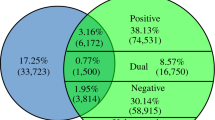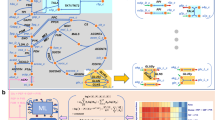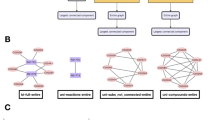Abstract
Cellular networks are subject to extensive regulation, which modifies the availability and efficiency of connections between components in response to external conditions. Thus far, studies of large-scale networks have focused on their connectivity, but have not considered how the modulation of this connectivity might also determine network properties. To address this issue, we analyzed how the coordinated expression of enzymes shapes the metabolic network of Saccharomyces cerevisiae. By integrating large-scale expression data with the structural description of the metabolic network, we systematically characterized the transcriptional regulation of metabolic pathways. The analysis revealed recurrent patterns, which may represent design principles of metabolic gene regulation. First, we find that transcription regulation biases metabolic flow toward linearity by coexpressing only distinct branches at metabolic branchpoints. Second, individual isozymes were often separately coregulated with distinct processes, providing a means of reducing crosstalk between pathways using a common reaction. Finally, transcriptional regulation defined a hierarchical organization of metabolic pathways into groups of varying expression coherence. These results emphasize the utility of incorporating regulatory information when analyzing properties of large-scale cellular networks.
This is a preview of subscription content, access via your institution
Access options
Subscribe to this journal
Receive 12 print issues and online access
$209.00 per year
only $17.42 per issue
Buy this article
- Purchase on Springer Link
- Instant access to full article PDF
Prices may be subject to local taxes which are calculated during checkout




Similar content being viewed by others
References
Ho, Y. et al. Systematic identification of protein complexes in Saccharomyces cerevisiae by mass spectrometry. Nature 415, 180–183 (2002).
Gavin, A.C. et al. Functional organization of the yeast proteome by systematic analysis of protein complexes. Nature 415, 141–147 (2002).
Uetz, P. et al. A comprehensive analysis of protein-protein interactions in Saccharomyces cerevisiae. Nature 403, 623–627 (2000).
Ito, T. et al. A comprehensive two-hybrid analysis to explore the yeast protein interactome. Proc. Natl. Acad. Sci. USA 98, 4569–4574 (2001).
Lee, T.I. et al. Transcriptional regulatory networks in Saccharomyces cerevisiae. Science 298, 799–804 (2002).
Hartwell, L.H., Hopfield, J.J., Leibler, S. & Murray, A.W. From molecular to modular cell biology. Nature 402, C47–C52 (1999).
Segre, D., Vitkup, D. & Church, G.M. Analysis of optimality in natural and perturbed metabolic networks. Proc. Natl. Acad. Sci. USA 99, 15112–15117 (2002).
Ibarra, R.U., Edwards, J.S. & Palsson, B.O. Escherichia coli K-12 undergoes adaptive evolution to achieve in silico predicted optimal growth. Nature 420, 186–189 (2002).
Stelling, J., Klamt, S., Bettenbrock, K., Schuster, S. & Gilles, E.D. Metabolic network structure determines key aspects of functionality and regulation. Nature 420, 190–193 (2002).
DeRisi, J.L., Iyer, V.R. & Brown, P.O. Exploring the metabolic and genetic control of gene expression on a genomic scale. Science 278, 680–686 (1997).
Miki, R. et al. Delineating developmental and metabolic pathways in vivo by expression profiling using the RIKEN set of 18,816 full-length enriched mouse cDNA arrays. Proc. Natl. Acad. Sci. USA 98, 2199–2204 (2001).
Ravasz, E., Somera, A.L., Mongru, D.A., Oltvai, Z.N. & Barabasi, A.L. Hierarchical organization of modularity in metabolic networks. Science 297, 1551–1555 (2002).
Causton, H.C. et al. Remodeling of yeast genome expression in response to environmental changes. Mol. Biol. Cell 12, 323–337 (2001).
Gasch, A.P. et al. Genomic expression programs in the response of yeast cells to environmental changes. Mol. Biol. Cell 11, 4241–4257 (2000).
Hughes, T.R. et al. Functional discovery via a compendium of expression profiles. Cell 102, 109–126 (2000).
Eisen, M.B., Spellman, P.T., Brown, P.O. & Botstein, D. Cluster analysis and display of genome-wide expression patterns. Proc. Natl. Acad. Sci. USA 95, 14863–14868 (1998).
Tavazoie, S., Hughes, J.D., Campbell, M.J., Cho, R.J. & Church, G.M. Systematic determination of genetic network architecture. Nat. Genet. 22, 281–285 (1999).
Tamayo, P. et al. Interpreting patterns of gene expression with self-organizing maps: methods and application to hematopoietic differentiation. Proc. Natl. Acad. Sci. USA 96, 2907–2912 (1999).
Ihmels, J. et al. Revealing modular organization in the yeast transcriptional network. Nat. Genet. 31, 370–377 (2002).
Kanehisa, M., Goto, S., Kawashima, S. & Nakaya, A. The KEGG databases at GenomeNet. Nucleic Acids Res. 30, 42–46 (2002).
Nelissen, B., De Wachter, R. & Goffeau, A. Classification of all putative permeases and other membrane plurispanners of the major facilitator superfamily encoded by the complete genome of Saccharomyces cerevisiae. FEMS Microbiol. Rev. 21, 113–134 (1997).
Giaever, G. et al. Functional profiling of the Saccharomyces cerevisiae genome. Nature 418, 387–391 (2002).
Bergmann, S., Ihmels, J. & Barkai, N. The Iterative Signature Algorithm for the analysis of large scale gene expression data. Phys. Rev. E 67, 031902 (2003).
Jeong, H., Tombor, B., Albert, R., Oltvai, Z.N. & Barabasi, A.L. The large-scale organization of metabolic networks. Nature 407, 651–654 (2000).
Schaaff, I., Heinisch, J. & Zimmermann, F.K. Overproduction of glycolytic enzymes in yeast. Yeast 5, 285–290 (1989).
Acknowledgements
We thank Sven Bergmann, Avigdor Eldar and Benny Shilo for comments on the manuscript. This work was supported by US National Institutes of Health grant no. A150562, by the Israeli Science Ministry and by the Y. Leon Benoziyo Institute for Molecular Medicine. N.B. is the incumbent of the Soretta and Henry Shapiro career development chair at the Weizmann Institute of Science.
Author information
Authors and Affiliations
Corresponding author
Ethics declarations
Competing interests
The authors declare no competing financial interests.
Rights and permissions
About this article
Cite this article
Ihmels, J., Levy, R. & Barkai, N. Principles of transcriptional control in the metabolic network of Saccharomyces cerevisiae. Nat Biotechnol 22, 86–92 (2004). https://doi.org/10.1038/nbt918
Received:
Accepted:
Published:
Issue Date:
DOI: https://doi.org/10.1038/nbt918
This article is cited by
-
Degron masking outlines degronons, co-degrading functional modules in the proteome
Communications Biology (2022)
-
Emerging mechanistic insights into the regulation of specialized metabolism in plants
Nature Plants (2022)
-
Elucidation of terpenoid metabolism in Scoparia dulcis by RNA-seq analysis
Scientific Reports (2017)
-
The metabolic background is a global player in Saccharomyces gene expression epistasis
Nature Microbiology (2016)
-
Integration of Metabolic Modeling with Gene Co-expression Reveals Transcriptionally Programmed Reactions Explaining Robustness in Mycobacterium tuberculosis
Scientific Reports (2016)



